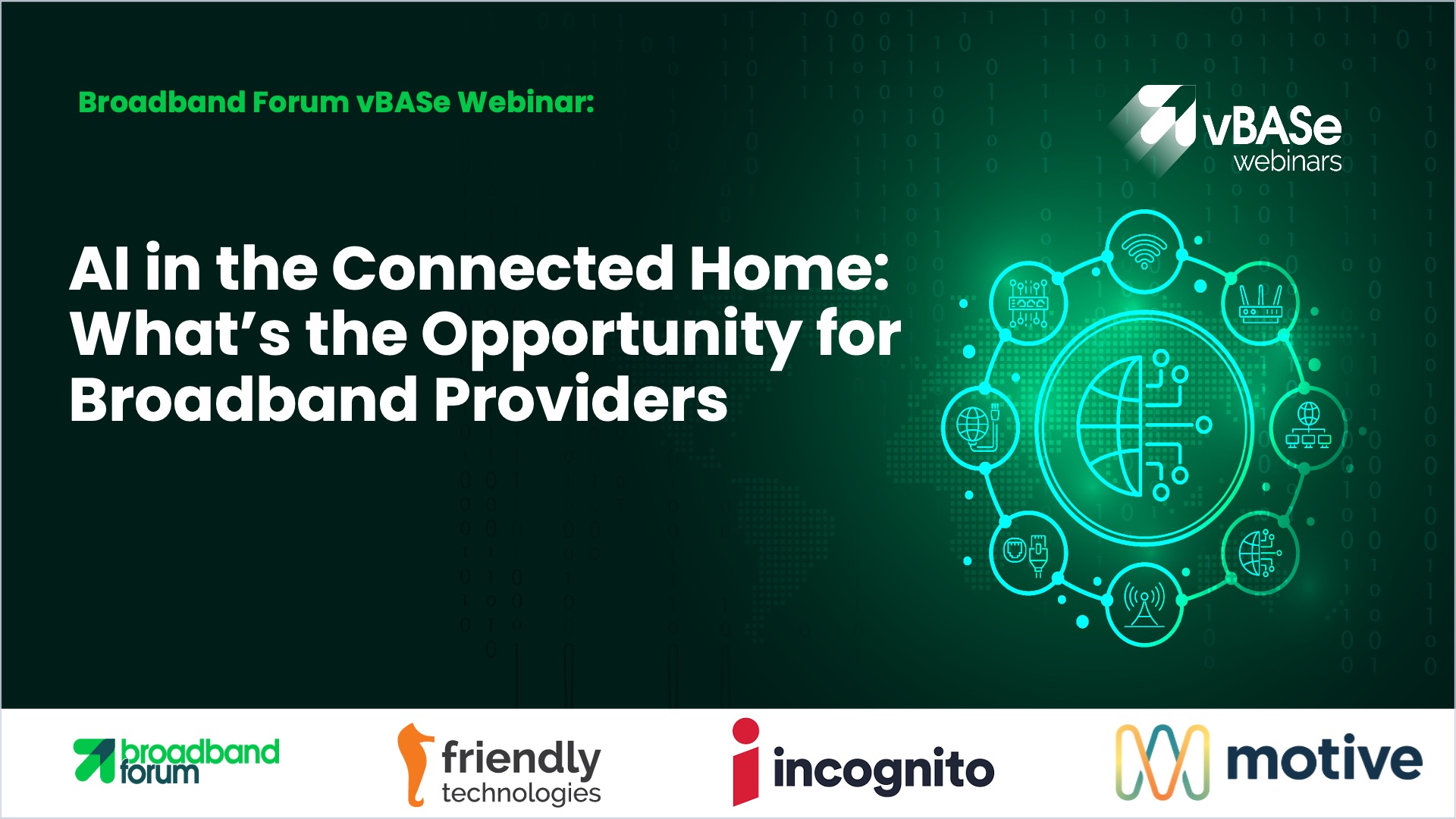By Ken Pyle, Marketing Director at Broadband Forum
AI-powered networks have the potential to transform the way broadband is delivered, experienced and monetized. In a recent Broadband Forum webinar, I was joined by industry experts to explore the question of what the service provider’s end goal is for AI – and where they should start. Guests from Motive, Incognito Software Systems and Friendly Technologies delivered key ways in which AI is taking broadband delivery, experience and business models to the next level in the connected home.
Better customer service care
Broadband service care continues to evolve, moving towards an autonomous, proactive model that decreases the operating costs and effort for the service provider. But it goes even further than this, said Motive’s Product Director Colin Grealish, empowering the ability to offer more personalized and improved IoT experiences for the end user.
For instance, 60% of Gen Z prefer solving issues by themselves, rather than contacting call centres and having to explain the issues. As the tech-savvy generation place high emphasis on speed and convenience when it comes to customer support, the likes of virtual assistants or chat bots that operate 24/7 have been highlighted as key in providing this wanted personalized experience.
Virtual assistants usually provide a response, which includes a snippet from a troubleshooting guide that may be applicable to the user’s issue. However, this type of service care has the potential to become even more personalized for the end user, with AI (GenAI) expected to have a huge impact. Respondents to a Gartner survey, Top Priorities for Customer Service Leaders in 2024, said virtual customer assistants and virtual agent assistants are the two use cases that GenAI will have the biggest impact on.
Broadband service providers must remain agile in their approach to service care, whether that be field care, assisted care, self-care or autonomous care. As new generations of broadband users emerge and the reliance on continuous connectivity increases, GenAI will play a crucial role in delivering the autonomous care experience these users increasingly require.
Improving – and introducing – broadband services
AI can also have a huge impact on the broadband and Wi-Fi experience. Jhuli Takahara, Product & Innovation Manager at Incognito referenced Omdia’s ‘AI in Network Operations’ survey figures that showed 40% of service provider respondents are using AI to improve customer experience, both to improve current services but also offer new ones – such as traffic improvement for gaming.
Jhuli highlighted a number of challenges faced by service providers from increasing revenues to the fact that customer experience is not solely about Wi-Fi connectivity. These barriers can be broken down by approaches and methods such as introducing AI into the network, intent-driven products and operational automation, and increased collaboration across the industry.
Quality of Experience (QoE), consumer IoT, anomaly detection and security were the four areas that Jhuli focused on as offering AI-powered use cases in broadband services. Wi-Fi management service and quality measurement (supported by Broadband Forum projects including OB-STAMP, L4S, and OB-UDPST speed tests) can be enhanced with AI to better diagnose network issues.
On consumer IoT, integration with devices like Alexa can be used to check the connectivity status and issues for proactive connectivity management. When it comes to anomaly detection, AI can be used to predict potential issues and proactively plan maintenance actions. For Security, AI’s ability to highlight vulnerabilities and fraud can be key to protect customer data and ensure a secure network.
Unlocking new business models for service providers
Tzvi Skapinker, CCO & VP of Product Management at Friendly Technologies wrapped up the webinar by discussing the ways that AI is being and can be used to transform connected home business models.
The surge in connected devices and digital services, customer expectations, fierce competition for broadband providers, and the need for better operational efficiency and cost optimization are the key market drivers for the integration of AI.
Tzvi summarised four AI-powered business models:
- QoE as a Service, which offers predictive maintenance and quality guarantees
- AI-driven customer support which includes virtual agents, bots and reduced OPEX
- Data monetization and insights such as anonymized data sales and behaviour analytics
- And, finally, IoT orchestration and platform integration fees under the model of Smart Home Management
However, there are challenges for service providers to consider in the implementation of AI when providing new services. AI relies on data, so it is imperative that data privacy and compliance with GDPR rules, for example, are ensured. Integrating AI with legacy systems can also be complex, so engineers and data scientists familiar with AI are required. Tzvi also stressed the need to manage the expectations of what AI can deliver.
The future of outlook for AI
The advancement in standards – such as USP (TR-369) – and open source software has unlocked more opportunities for data collection on the home network and ultimately, service enhancement. AI can use this data to create agile networks that deliver more personalized experiences for the end user.
AI is augmenting the home network experience by addressing its challenges and transforming limitations into opportunities for improvement. By optimizing existing resources and identifying gaps - whether it is enhancing network performance or suggesting additional equipment and bandwidth - AI not only improves the quality of service but also opens doors for strategic upselling that benefits both providers and consumers.
You can view the full discussion in the ‘AI in the Connected Home: What’s the Opportunity for Broadband Providers’ vBASe Webinar here: https://youtu.be/HBJ30y5x0bQ?si=Wx7NpMt9K9P_H0Ag
